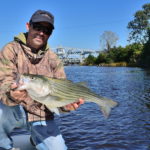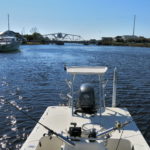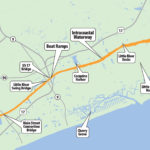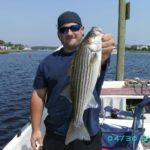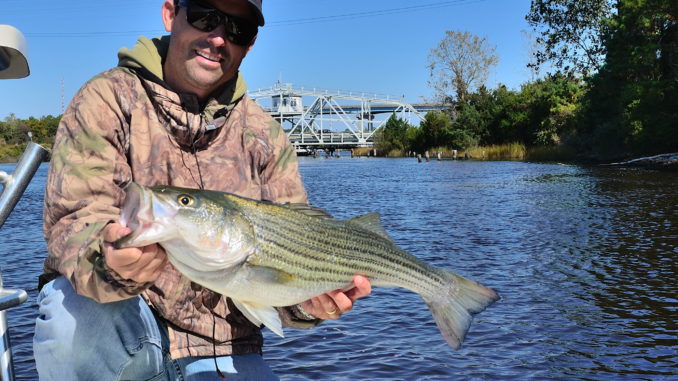
Little River stripers are likely from other coastal river populations
As the New Year arrives, fishermen along the Grand Strand have plenty to look forward to besides cold weather and college basketball on television, such as the striped bass that take up winter residence in the Little River section of the Atlantic Intracoastal Waterway.
Striped bass are one of the seven anadromous species along the Atlantic coast that journey up coastal rivers to spawn during the spring, but they are one of a very few that overwinters in coastal waters. Whether coming in from the ocean or downstream from the upper reaches of the watershed, they are in coastal estuaries to fuel up for their move back upriver in a few months. And the waters of the ICW around Little River provide an ideal platform for baitfish and striped bass.
According to Scott Lamprecht, striped bass project leader for the S.C. Carolina Department of Natural Resources, the stripers that spend the winter in the ICW are most likely from neighboring river systems.
“In my best judgment, they are part of the Pee Dee System,” he says. “Coastal river striped bass are highly migratory, but South Carolina populations don’t do the major coastal river migrations that you see in the north.”
Typically, striped bass make long spawning runs. Most, especially the ones frequenting the waters between North Carolina and Maine, will follow a routine migration route along the coast and into specific river systems thought to be the ones where they were hatched. But the striped bass in South Carolina waters tend to behave differently than their Yankee cousins.
Data from several tagging studies over the past few years has revealed that stripers will trade between river systems.
“We always assumed that our local striper populations were homebodies and didn’t move that far, but there is a lot of in-stream movement between adjoining river systems,” Lamprecht said. “For instance, one fish that was tagged in the Santee was re-captured just below Blewett Falls Dam on the Pee Dee during a spring run. And then, the same fish was recaptured back in the Santee the following year.”
The federally-endangered short nose sturgeon is another anadromous fish that ventures up coastal rivers to spawn. Historically, sturgeon movements have mimicked striped bass spawning rituals, and they are often found in the same type habitats. Evidence from recent studies in short nose sturgeon has illustrated movements between river systems.
“We suspect that stripers should behave very similar and are probably doing a lot more that we realize. I suspect the ICW serves as a mechanism to help them disperse between the river systems,” Lamprecht said.
Fishermen can expect a slug of stripers to show up around Little River during the fall and winter to take advantage of the unique conditions.
“They go downriver in the estuarine zones, where it is real easy living and where the warmest water occurs. Those areas are rich and are the most productive part of the system from December through March. That time of year, eating drives their activity,” Lamprecht said.
Typically, the ICW along the North Carolina/South Carolina border and the Little River swing bridge sees a flurry of speckled trout anglers between October and Christmas. Huge schools of trout stack up in this area to chow down on the abundant baitfish and shrimp. Stripers generally take over when the trout move into their winter stance. Fishermen can expect to find stripers in the same places where trout lived just a few weeks earlier.
“Unlike the sedentary largemouth (bass), stripers are moving all of the time and will hold up in places adjacent or within swift current,” Lamprecht said.
Where the bait is staging will give away the locations of winter stripers.
Capt. Brian Costello of Fish-On Outfitters in Cherry Grove concentrates between the Robert Edge Parkway (Main Street Connector) and the lighthouse, but he will fish from as far south as Barefoot Landing to as far north as Calabash Creek.
“We concentrate on the bridges, docks and anywhere there is a depth change that is holding bait,” said Costello (843-249-2600). “The fish will stage in places where the current is broken by a bridge piling or a shallow hump.”
The ICW in this area is narrow and confines the flow. Costello will fish around these submerged obstacles using a mixture of tactics from live bait to artificials.
“Live finger mullet sunk to the bottom is my favorite. It really gets them going,” said Costello, who will cast large finger mullet under one or two ounces of lead around bridge pilings and creek mouths during periods of steady flow. He will move from spot to spot until he finds a willing contender.
“Live bait is my favorite,” he said, “but casting heavy jigs will also produce good bites when the mullet is hard to find.”
Since the currents are strong and water depths will range from 15 to 25 feet, anglers must use relatively heavy jigs to get the lures to the bottom where the fish live. Jigs from ½- to ¾- ounce are typically heavy enough to get the lures down. Jig bodies should be anywhere from five to seven inches long with a shad tail, screw tail, or just a straight-tail configuration. The best colors are pearl, chartreuse, green and gold. Anglers should cast along structure and slowly work lures along bottom.
While casting can provide great action when a good congregation of fish is around, stripers are a highly mobile species that will move around a lot throughout the day looking for congregations of bait in areas with current.
Costello will troll along the ICW on the channel ledges and any place where the current is abruptly changed by some type of submerged structure.
“I will troll to find the fish most of the time,” said Costello, who prefers deep-diving or suspending crankbaits and double-rigged plastic swimbaits in a variety of color combinations. Typically, stripers are near the bottom near the channel breaks or adjacent to structure.
“I troll two knots or so, depending on the current, and if the tide is falling or rising,” Costello said.
Again, stripers prefer setting up in areas of heavy current. Costello marks his winter calendar for big tides on full and new moons.
“The heavy currents really get them active and feeding well,” he said.
Typically, Little River stripers range from two to 12 pounds, but reports of trophy-sized fish exceeding 20 to 25 pounds are heard every year. Be prepared with heavy tackle, braided line and a rod with backbone to get these fish to the boat.
While some anglers are counting the days until spring, anglers ready to lock into a powerful opponent can make it happen during the winter months along the Little River section of the ICW.
DESTINATION INFORMATION
HOW TO GET THERE — Little River is at the intersection of the Atlantic Intracoastal Waterway, US 17 and SC 9 at Nixon’s Crossroads, Northwest of North Myrtle Beach and Cherry Grove Beach. Public boat ramps are under the US 17 Bridge on both sides of the ICW. The best striper fishing from Calabash Creek south to the Robert Edge Parkway bridge in North Myrtle Beach. The Socastee swing bridge and structure along the ICW will hold winter stripers.
WHEN TO GO — Stripers show up in the ICW around Little River in October and will stay through March. Fishing is best when the water temperature drops below 65 degrees. As the water cools, expect stripers to continue to feed through the winter months.
LICENSE REQUIREMENTS — The U.S. 17 bridge at Little River is the dividing line between saltwater and freshwater. A South Carolina freshwater fishing license is required south of the swing bridge, and a saltwater license is required north of the bridge.
LURES/TECHNIQUES — Baitfish imitations are the usual choice for stripers, and bright or natural colors — white, chartreuse and pink — are preferred. For artificials, large, soft-plastic baits fished on 1/2- to 1-ounce jigheads are preferred fished just off the bottom. Go with baits from four to seven inches and fish them slowly along current edges and drop-offs. Fish them even more slowly in off-color water. Trolling shallow- and deep-diving plugs upcurrent or downcurrent is effective and is ideal for locating concentrations of stripers. Use braided line with an 18-inch section of 20-pound fluorocarbon leader on 7-foot, medium-heavy spinning or baitcasting rods.
GUIDES/FISHING INFO — Capt. Brian Costello, Fish on Outfitters, 843-249-2600, www.fish-on-outfitters.com. See also Guides and Charters in Classifieds.
MAPS — Navionics, 800-848-5896, www.navionics.com, The Good Spots, 800-411-0185, www.thegoodspots.com; Delorme’s South Carolina Atlas & Gazetteer, 207-846-7000, www.delorme.com.
ACCOMMODATIONS — Hampton Inn/North Myrtle Beach Harbourgate, 843-249-1997; Myrtle Beach Area Convention and Visitors Bureau (www.mbchamber.com).

